Ask a question from expert
multi-stored buildings PDF
50 Pages9027 Words315 Views
Added on 2022-01-25
multi-stored buildings PDF
Added on 2022-01-25
BookmarkShareRelated Documents
ABSTRACT
In India, multi-stored buildings are usually constructed due to high cost and scarcity
of land. In order to utilize maximum land area, building and architects generally
propose asymmetrically plan configurations. These unsymmetrical plan buildings,
which are constructed in seismic prone areas, are likely to experience more damage
during earthquake. Earthquake is a natural phenomenon which can generate the most
destructive forces on structures. In the present study, four different models with
symmetric circular and rectangular plan constructed on soft rocky soil in seismic
zone V of India (as per IS: 1893-2016) are considered. Linear and static analysis
using the software in STAAD PRO is carried out for all the plan. The objective of the
present study is to study the behavior and comparison of building frames under strong
column and weak beam & strong beam and weak column. It is observed that the
building with circular symmetric plan with strong column and weak beam performs
well compared to the other building plan. It is recommended that construction of
rectangular symmetric building with strong beam and weak column should be avoided
in earthquake prone regions.
1
In India, multi-stored buildings are usually constructed due to high cost and scarcity
of land. In order to utilize maximum land area, building and architects generally
propose asymmetrically plan configurations. These unsymmetrical plan buildings,
which are constructed in seismic prone areas, are likely to experience more damage
during earthquake. Earthquake is a natural phenomenon which can generate the most
destructive forces on structures. In the present study, four different models with
symmetric circular and rectangular plan constructed on soft rocky soil in seismic
zone V of India (as per IS: 1893-2016) are considered. Linear and static analysis
using the software in STAAD PRO is carried out for all the plan. The objective of the
present study is to study the behavior and comparison of building frames under strong
column and weak beam & strong beam and weak column. It is observed that the
building with circular symmetric plan with strong column and weak beam performs
well compared to the other building plan. It is recommended that construction of
rectangular symmetric building with strong beam and weak column should be avoided
in earthquake prone regions.
1
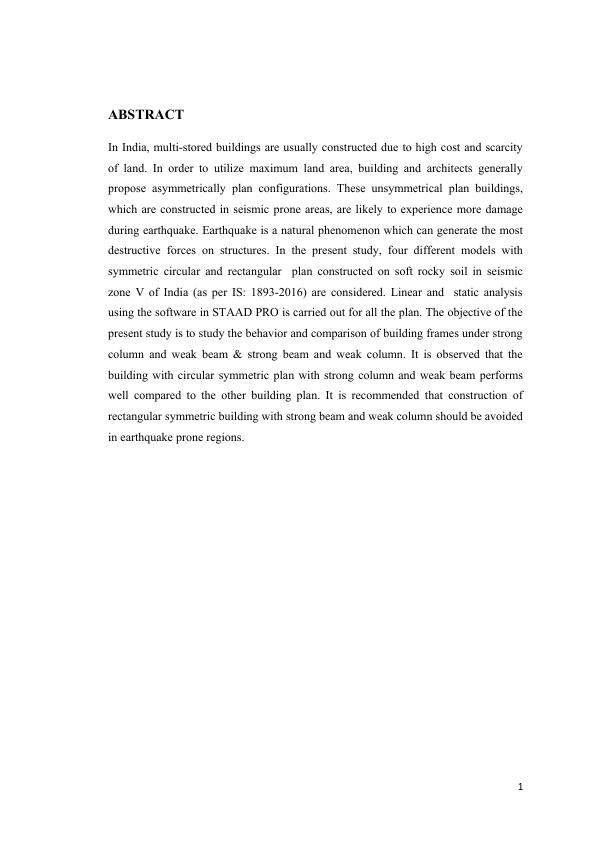
LIST OF SYMBOLS
A Design horizontal seismic coefficient
DL Dead load
E Modulus of elasticity
EQ Earthquake load along x direction
EQ Earthquake load along y direction
h Height of the structure
h Height measure from the base of the building to floor i
LL Live load
n Number of stores in the building
Q Lateral force at floor i
R Response reduction factor
Sa/g Average response acceleration coefficient for rock or soil sites based on
Appropriate natural periods and damping of the structure
V Design seismic base shear
T Approximate fundamental period of vibration of the structure
W Seismic weight of the structure
W Seismic weight of floor i
Z Zone factor
2
A Design horizontal seismic coefficient
DL Dead load
E Modulus of elasticity
EQ Earthquake load along x direction
EQ Earthquake load along y direction
h Height of the structure
h Height measure from the base of the building to floor i
LL Live load
n Number of stores in the building
Q Lateral force at floor i
R Response reduction factor
Sa/g Average response acceleration coefficient for rock or soil sites based on
Appropriate natural periods and damping of the structure
V Design seismic base shear
T Approximate fundamental period of vibration of the structure
W Seismic weight of the structure
W Seismic weight of floor i
Z Zone factor
2

List of table
Table No. Topic Page No.
4.1 Specification of the building 25
5.1 bending moment of circular building strong beam 36
5.2 bending moment of circular building strong column 36
5.3 bending moment of rectangular building strong beam 37
5.4 bending moment of rectangular building strong column 37
5.5 shear force of rectangular building strong beam 38
5.6 shear force of rectangular building strong column 38
5.7 shear force of circular building strong beam 39
5.8 shear force of circular building strong column 39
3
Table No. Topic Page No.
4.1 Specification of the building 25
5.1 bending moment of circular building strong beam 36
5.2 bending moment of circular building strong column 36
5.3 bending moment of rectangular building strong beam 37
5.4 bending moment of rectangular building strong column 37
5.5 shear force of rectangular building strong beam 38
5.6 shear force of rectangular building strong column 38
5.7 shear force of circular building strong beam 39
5.8 shear force of circular building strong column 39
3
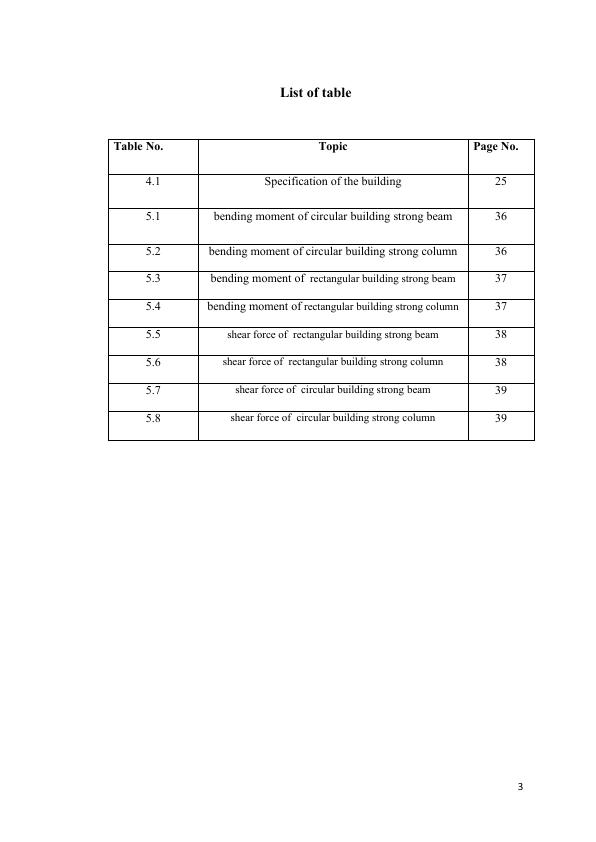
List of figure
Serial no. Title Page no.
Figure 4.4(a) Circular building plan 19
Figure 4.4(b) Rectangular building plan 19
Figure 4.4(c) Front view of circular
building plan
20
Figure 4.4(d) Front view of rectangular
building plan
20
Figure 4.4(e) whole plan of the circular
building
21
Figure 4.4(f) whole plan of the
rectangular building
21
Figure 4.4(g) 3D circular building plan
of weak column and
strong beam section
22
Figure 4.4(h) 3D rectangular building
plan of weak column and
strong beam section
22
Figure 4.4(i) 3D rectangular building
plan of strong column and
weak beam section
23
Figure 4.4(j) 3D circular building plan
of strong column and
weak beam section
23
Figure 4.5(a) Difference in deflection of
slab and beam adjacent
25
Figure 4.5(b) Discretization of beam 25
Figure 4.6.3 Distribution of lateral
forces at different levels at
which the masses are
located.
28
Figure 5.1.1(a) plate load under all
loading in circular
building plan with strong
column and weak beam
Front side
39
Figure 5.1.1(b) plate load under all
loading in circular
building plan with strong
column and weak beam
back side
39
Figure 5.1.2(a) plate load under all
loading in circular
building plan with weak
39
4
Serial no. Title Page no.
Figure 4.4(a) Circular building plan 19
Figure 4.4(b) Rectangular building plan 19
Figure 4.4(c) Front view of circular
building plan
20
Figure 4.4(d) Front view of rectangular
building plan
20
Figure 4.4(e) whole plan of the circular
building
21
Figure 4.4(f) whole plan of the
rectangular building
21
Figure 4.4(g) 3D circular building plan
of weak column and
strong beam section
22
Figure 4.4(h) 3D rectangular building
plan of weak column and
strong beam section
22
Figure 4.4(i) 3D rectangular building
plan of strong column and
weak beam section
23
Figure 4.4(j) 3D circular building plan
of strong column and
weak beam section
23
Figure 4.5(a) Difference in deflection of
slab and beam adjacent
25
Figure 4.5(b) Discretization of beam 25
Figure 4.6.3 Distribution of lateral
forces at different levels at
which the masses are
located.
28
Figure 5.1.1(a) plate load under all
loading in circular
building plan with strong
column and weak beam
Front side
39
Figure 5.1.1(b) plate load under all
loading in circular
building plan with strong
column and weak beam
back side
39
Figure 5.1.2(a) plate load under all
loading in circular
building plan with weak
39
4
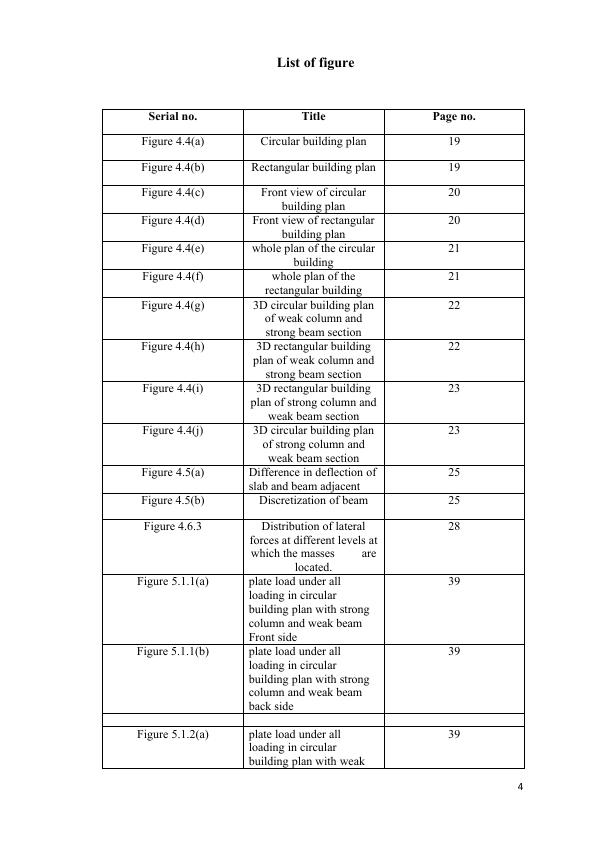
column and strong beam
Front side
Figure 5.1.2(b) plate load under all
loading in circular
building plan with weak
column and strong beam
back side
39
Figure 5.1.3(a) plate load under all
loading in rectangular
building plan with strong
column and weak beam
Front side
40
Figure 5.1.3(b) plate load under all
loading in rectangular
building plan with strong
column and weak beam
back side
40
Figure 5.1.4(a) plate load under all
loading in rectangular
building plan with weak
column and strong beam
Front side
41
Figure 5.1.4(b) plate load under all
loading in rectangular
building plan with weak
column and strong beam
back side
41
5
Front side
Figure 5.1.2(b) plate load under all
loading in circular
building plan with weak
column and strong beam
back side
39
Figure 5.1.3(a) plate load under all
loading in rectangular
building plan with strong
column and weak beam
Front side
40
Figure 5.1.3(b) plate load under all
loading in rectangular
building plan with strong
column and weak beam
back side
40
Figure 5.1.4(a) plate load under all
loading in rectangular
building plan with weak
column and strong beam
Front side
41
Figure 5.1.4(b) plate load under all
loading in rectangular
building plan with weak
column and strong beam
back side
41
5
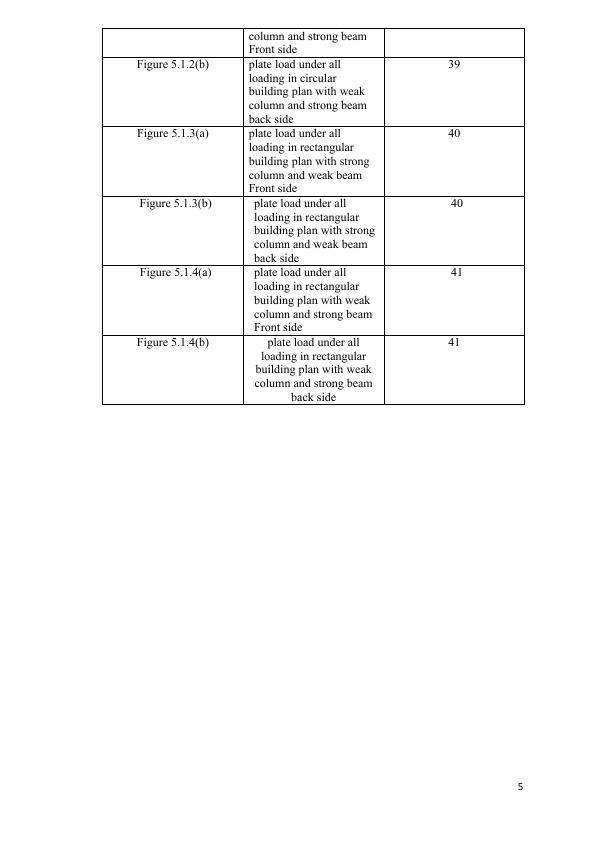
Contents
Chapter No. Topic Page No.
i List of figures
ii List of tables
iii List of symbols
iv Abstract
1 Introduction 7
1.1 General 8
1.2 Architectural behaviour of building 9
1.3 StaadPRO 10
2 Objective 12-13
3 Literature review 14-18
4 Methodology 19
4.1 Introduction 20
4.2 Purpose 20
4.3 Models of building 20
4.4 Description of building model 21-26
4.5 Slab and structural wall modelling 27
4.6 Loading 28-30
4.7 Load combination 30
4.8 Analysis method of structures 31-34
5 Results 35
5.1 Linear static analysis 36-42
6 Scope of future study 43-44
7 Conclusion 45-46
8 reference 47-48
6
Chapter No. Topic Page No.
i List of figures
ii List of tables
iii List of symbols
iv Abstract
1 Introduction 7
1.1 General 8
1.2 Architectural behaviour of building 9
1.3 StaadPRO 10
2 Objective 12-13
3 Literature review 14-18
4 Methodology 19
4.1 Introduction 20
4.2 Purpose 20
4.3 Models of building 20
4.4 Description of building model 21-26
4.5 Slab and structural wall modelling 27
4.6 Loading 28-30
4.7 Load combination 30
4.8 Analysis method of structures 31-34
5 Results 35
5.1 Linear static analysis 36-42
6 Scope of future study 43-44
7 Conclusion 45-46
8 reference 47-48
6
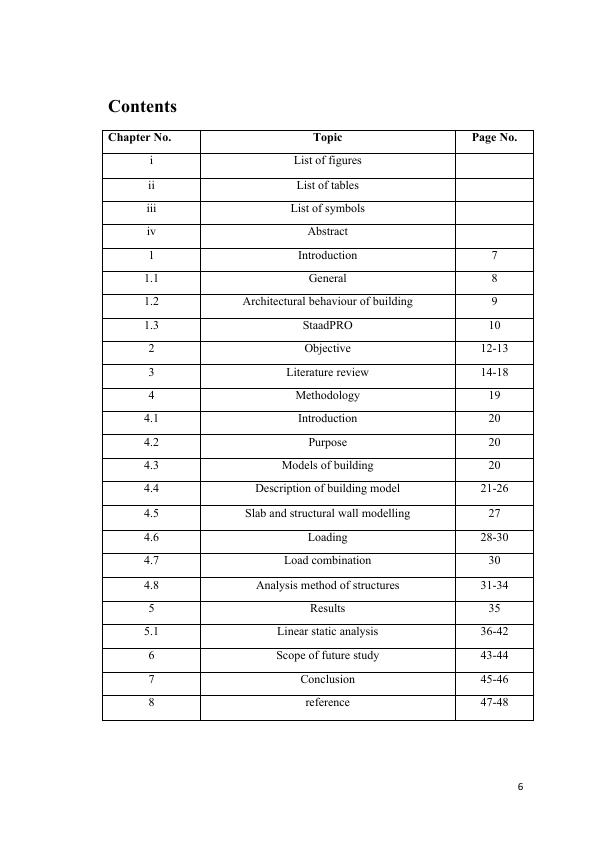
Chapter 1
Introduction
7
Introduction
7
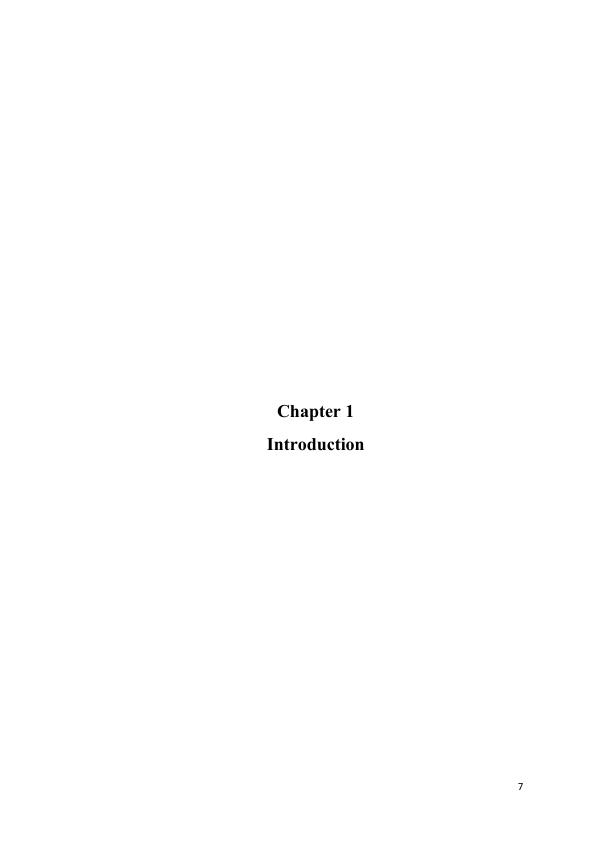
Introduction
1.1General
An earthquake also known as quake or tremor is the result of a sudden release of
energy in the earth’s crust that creates seismic waves. The most important cause from
an engineering point of view, it is believed at present, is the movement of faults which
are buried deep below the earth surface.
Earthquake has always been a thread to human civilization from the day of its
existence, devastating human lives, properly and manmade structures. The very recent
earthquake that we faced in our neighbouring country Nepal has again shown nature’s
fury, causing such a massive destruction to the country and its people. It is such an
unpredictable calamity that it is very necessary for survival to ensure the strength to
the structures against seismic forces. Therefore, there is a continuous research work
going on around the world, resolving around development of new and better
techniques to resist the damages during seismic against failures under seismic forces it
is a prerequisite.
Earthquake cause ground to vibrate and these results a lateral forces on the surface.
Earthquakes don’t kill people but poorly built buildings do. Poorly built buildings
include poor quality of materials used poor shape of the buildings and poor design
without considering the codal provisions. Several countries including India have
experienced severe losses in the past, in terms of human casualty and property; most
recent are the bhuj earthquake of 26th January, 2001; Sumatra earthquake of 26th
December, 2004 leading to tsunami and Kashmir earthquake of 8th October, 2005.
Most of the casualties were due to collapse of poorly constructed buildings in the
seismically vulnerable regions.
Earthquake caused random ground motions, in all possible direction emanating from
the epicentre. Vertical ground motions are rare, but an earthquake is always
accompanied with horizontal ground shaking. The ground vibration causes the
structures resisting on the ground to vibrate, developing inertial forces in the structure.
As the earthquake changes directions, it can cause reversal of stresses in the stresses
in the structural components that is tension may change to compression and
8
1.1General
An earthquake also known as quake or tremor is the result of a sudden release of
energy in the earth’s crust that creates seismic waves. The most important cause from
an engineering point of view, it is believed at present, is the movement of faults which
are buried deep below the earth surface.
Earthquake has always been a thread to human civilization from the day of its
existence, devastating human lives, properly and manmade structures. The very recent
earthquake that we faced in our neighbouring country Nepal has again shown nature’s
fury, causing such a massive destruction to the country and its people. It is such an
unpredictable calamity that it is very necessary for survival to ensure the strength to
the structures against seismic forces. Therefore, there is a continuous research work
going on around the world, resolving around development of new and better
techniques to resist the damages during seismic against failures under seismic forces it
is a prerequisite.
Earthquake cause ground to vibrate and these results a lateral forces on the surface.
Earthquakes don’t kill people but poorly built buildings do. Poorly built buildings
include poor quality of materials used poor shape of the buildings and poor design
without considering the codal provisions. Several countries including India have
experienced severe losses in the past, in terms of human casualty and property; most
recent are the bhuj earthquake of 26th January, 2001; Sumatra earthquake of 26th
December, 2004 leading to tsunami and Kashmir earthquake of 8th October, 2005.
Most of the casualties were due to collapse of poorly constructed buildings in the
seismically vulnerable regions.
Earthquake caused random ground motions, in all possible direction emanating from
the epicentre. Vertical ground motions are rare, but an earthquake is always
accompanied with horizontal ground shaking. The ground vibration causes the
structures resisting on the ground to vibrate, developing inertial forces in the structure.
As the earthquake changes directions, it can cause reversal of stresses in the stresses
in the structural components that is tension may change to compression and
8
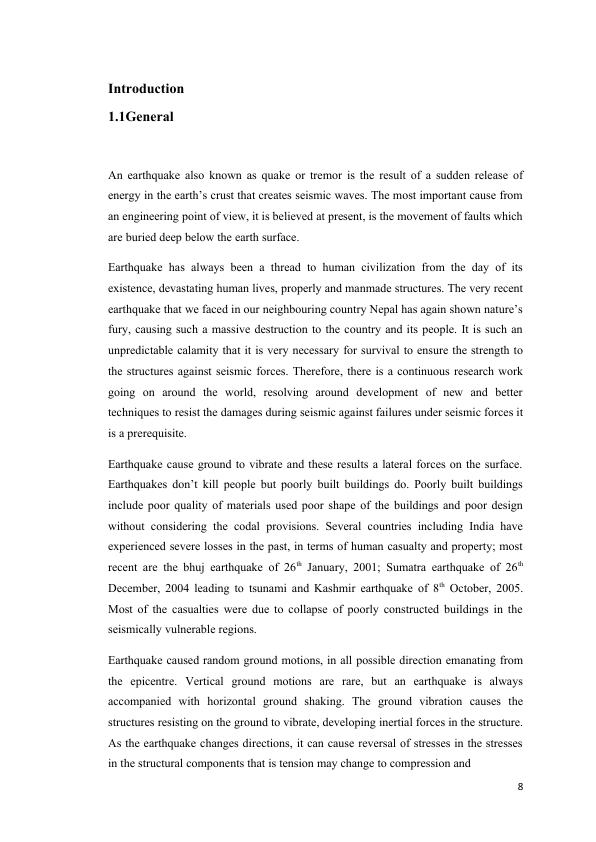
End of preview
Want to access all the pages? Upload your documents or become a member.
Related Documents
Sittingbourne Footing System Assignmentlg...
|27
|1880
|48
Concept of Practical Beam | Reportlg...
|14
|1230
|23
Earthquake Engineering - Articlelg...
|3
|498
|18
Understanding Beams: Behavior, Failure Modes, Stresses, and Types Used in Constructionlg...
|13
|2852
|300
Earthquake Vibration Control Assignmentlg...
|19
|4080
|230
Design of Columns, Beams and Slabs for an Eight-Storey Office Buildinglg...
|57
|1661
|73